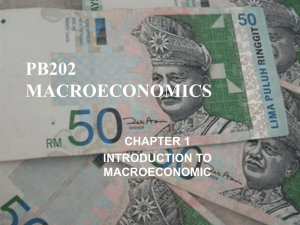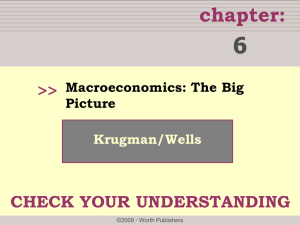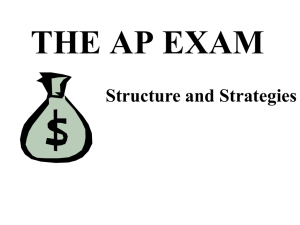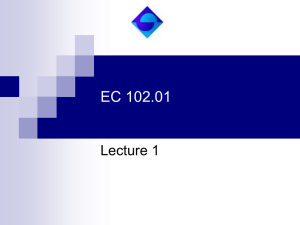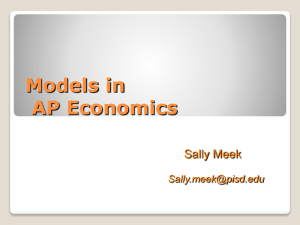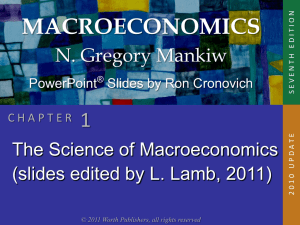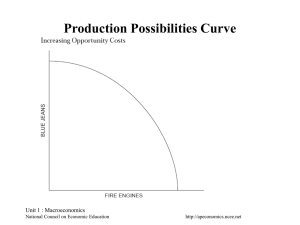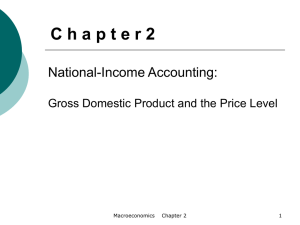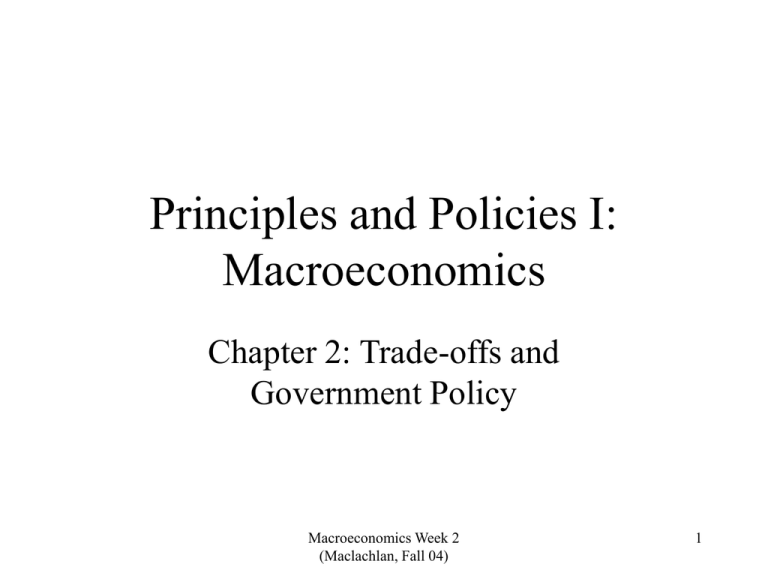
Principles and Policies I:
Macroeconomics
Chapter 2: Trade-offs and
Government Policy
Macroeconomics Week 2
(Maclachlan, Fall 04)
1
Prob. 1-3
Donor: gains $30,000, loses one of two kidneys and
takes on risk associated with any surgery.
Recipient: loses $30,000, gains a working kidney.
Both could be said to benefit if they undergo the
transaction voluntarily and with full knowledge.
But such a transaction is illegal because of the view
that not everything should be for sale—a social
force embodied in law through the political
process.
Macroeconomics Week 2
(Maclachlan, Fall 04)
2
Prob. 1-5
Micro or Macro?
a) Should the U.S. government use a policy of
free trade with China to encourage China t
advance human rights?
Micro with macro implications.
Macroeconomics Week 2
(Maclachlan, Fall 04)
3
b) Will the fact that more and more doctors
are selling their practices to managed care
networks increase the efficiency of medical
providers.
Micro
Macroeconomics Week 2
(Maclachlan, Fall 04)
4
c) Should the current federal income tax
structure be eliminated in favor of a flat
tax?
Micro with macro implications.
Macroeconomics Week 2
(Maclachlan, Fall 04)
5
d) Should the minimum wage be raised?
Micro with macro implications.
Macroeconomics Week 2
(Maclachlan, Fall 04)
6
e) Should AT&T and Verizon both be allowed
to build local phone networks?
Micro.
Macroeconomics Week 2
(Maclachlan, Fall 04)
7
f) Should commercial banks be required to
provide loans in all areas of the territory
from which they accept deposits?
Macro.
Macroeconomics Week 2
(Maclachlan, Fall 04)
8
Chapter Two Learning Objectives
You should be able to:
•
•
•
•
Demonstrate opportunity cost with a PPC.
Relate the concept of comparative advantage to the PPC.
State the principle of increasing marginal cost.
State how through comparative advantage and trade,
production possibilities increase.
• State six roles of government.
• Compare the regulation of international markets to the
regulation of domestic markets.
Macroeconomics Week 2
(Maclachlan, Fall 04)
9
A Production Possibility Curve
for a Society
10
9
8
7
6
5
4
3
2
1
0
McGraw-Hill/Irwin
If the slope of the production
curve is -2 at A, the
A
opportunity cost
of 1X is 2Y.
2Y
.
1X
1
2
3
4
5
6
7
8
9
X
© 2004 The McGraw-Hill Companies, Inc., All Rights Reserved.
A Production Possibilities Table and Curve
(Graph with guns on horizontal axis.)
% of resources
% of resources
devoted to
devoted to
production
production
Pounds
Number
of guns
of butter
of butter
of guns
0
20
40
60
80
100
McGraw-Hill/Irwin
0
4
7
9
11
12
100
80
60
40
20
0
15
14
12
9
5
0
Row
A
B
C
D
E
F
© 2004 The McGraw-Hill Companies, Inc., All Rights Reserved.
A Production Possibilities Table
and Curve
Butter
1 pound 15 A
of butter
14
2 pounds
of butter 12
B
C
D
9
5
E
5 pounds
of butter
0
4
4 guns
McGraw-Hill/Irwin
7
3 guns
9
F
11 12 Guns
1 gun
© 2004 The McGraw-Hill Companies, Inc., All Rights Reserved.
Increasing Marginal Opportunity
Cost
• The principle of increasing marginal
opportunity cost states that opportunity
costs increase the more you concentrate on
an activity.
• In order to get more of something, one must
give up ever-increasing quantities of
something else.
Macroeconomics Week 2
(Maclachlan, Fall 04)
13
Increasing Marginal Opportunity
Cost
A
Slope is flat at A. Low
opportunity cost of
guns.
Slope is steep at B. High
opportunity cost of guns.
B
Guns
Macroeconomics Week 2
(Maclachlan, Fall 04)
14
Adam Smith (1723-1790)
Critic of mercantilism.
Countries should
specialize and trade.
Specialize where there’s
an ABSOLUTE
ADVANTAGE
Macroeconomics Week 2
(Maclachlan, Fall 04)
15
ABSOLUTE ADVANTAGE
A region has an absolute advantage if it takes
fewer resources to produce a good there
than elsewhere.
Coffee in Columbia.
Computer software in Silicon Valley.
Macroeconomics Week 2
(Maclachlan, Fall 04)
16
David Ricardo (1772-1823)
Theory of comparative
advantage.
Even without an absolute
advantage a region can
trade to the benefit of
all parties.
Macroeconomics Week 2
(Maclachlan, Fall 04)
17
The Benefits of Trade
• The argument for the benefits of trade
underlies the general policy of laissez-faire.
– Laissez-faire – an economic policy of leaving
coordination of individuals’ actions to the market.
Macroeconomics Week 2
(Maclachlan, Fall 04)
18
Production Possibilities without
Trade
• Pakistan can produce 4,000 yards of textile
per day or 1 ton of chocolate per day.
• Belgium can produce 1,000 yards of textile
a day or 4 tons of chocolate per day.
Macroeconomics Week 2
(Maclachlan, Fall 04)
19
Production Possibilities without
Trade
• Pakistan has a comparative advantage in
producing textiles.
• Belgium has a comparative advantage in
chocolate.
Macroeconomics Week 2
(Maclachlan, Fall 04)
20
Textiles
(in thousands of yards)
Production Possibilities without
Trade
5
4
Pakistan
3
2
Belgium
1
1
2
3
4
5
Chocolate (in tons)
McGraw-Hill/Irwin
© 2004 The McGraw-Hill Companies, Inc., All Rights Reserved.
Production Possibilities without
Trade
• Pakistan has chosen to produce 2,000 yards
of textiles and 0.5 tons of chocolate.
• Belgium has chosen to produce 500 yards of
textile and 2 tons of chocolate.
Macroeconomics Week 2
(Maclachlan, Fall 04)
22
Production Possibilities without
Trade
• Point A: The combination of textile and
chocolate chosen by Pakistan.
• Point B: The combination of textile and
chocolate chosen by Belgium.
• Point C: The joint combination without trade.
Macroeconomics Week 2
(Maclachlan, Fall 04)
23
Production Possibilities without
Trade
Pakistan’s and Belgium’s Individual Possibilities
Textile per day
Chocolate per day
Pakistan
2,000 yards
0.5 ton
Belgium
500 yards
2 tons
Total
2,500 yards
2.5 tons
Macroeconomics Week 2
(Maclachlan, Fall 04)
24
Textiles
(in thousands of yards)
Production Possibilities without
Trade
5
4
Pakistan
3
2
C
A
Belgium
B
1
1
2
3
4
5
Chocolate (in tons)
McGraw-Hill/Irwin
© 2004 The McGraw-Hill Companies, Inc., All Rights Reserved.
Production Possibilities without
Trade
• The two extreme combinations are both
countries producing only textile (point
D) and both producing only chocolate
(point E).
• The combined production possibilities curve
with no trade is drawn by connecting these two
points.
Macroeconomics Week 2
(Maclachlan, Fall 04)
26
Textiles
(in thousands of yards)
Production Possibilities without
Trade
5
D
4
Pakistan
3
2
C
Joint (no trade)
A
Belgium
B
1
1
2
3
4
E
5
Chocolate (in tons)
McGraw-Hill/Irwin
© 2004 The McGraw-Hill Companies, Inc., All Rights Reserved.
Production Possibilities with
Trade
• Point F: This is where each nation is
focusing on that activity for which it has a
comparative advantage.
– Pakistan produces 4,000 yards of textile.
– Belgium produces 4 tons of chocolate.
Macroeconomics Week 2
(Maclachlan, Fall 04)
28
Production Possibilities with
Trade
Combined Production Possibilities
No Trade
Fabric
Chocolate
Specializing
and Trade
Gains to
Trade
2,500 yards 4,000 yards 1,500 yards
2.5 Tons
4 tons
Macroeconomics Week 2
(Maclachlan, Fall 04)
1.5 Tons
29
Textiles
(in thousands of yards)
Production Possibilities with
Trade
5
D
Gains from trade
Joint (with trade)
F
4
3
C
Joint (no trade)
2
1
1
2
3
4
E
5
Chocolate (in tons)
McGraw-Hill/Irwin
© 2004 The McGraw-Hill Companies, Inc., All Rights Reserved.
Production Possibilities with
Trade
• The combined PPC is bowed out because of
Point F – comparative advantage and
specialization.
Macroeconomics Week 2
(Maclachlan, Fall 04)
31
The Roles of Government in a
Market
• Provide a stable institutional framework.
• Promote effective and workable
competition.
• Correct for externalities.
• Ensure economic stability and growth.
• Provide public goods.
• Adjust for undesired market results.
Macroeconomics Week 2
(Maclachlan, Fall 04)
32
Provide a Stable Set of
Institutions and Rules
• Government can create a stable
environment and enforce contracts through
its legal system.
• Economic growth is difficult when
government does not provide a stable
environment.
Macroeconomics Week 2
(Maclachlan, Fall 04)
33
Promote Effective and Workable
Competition
• Government promotes competition and
protect against monopolies.
– Monopoly power is the ability of individuals or
firms currently in business to prevent other
individuals or firms from entering the same
kind of business
Macroeconomics Week 2
(Maclachlan, Fall 04)
34
Promote Effective and Workable
Competition
• Monopoly power gives existing firms or
individuals the power to raise prices.
• Market participants often insist on open
competition except when it comes to
themselves.
Macroeconomics Week 2
(Maclachlan, Fall 04)
35
Correct for Externalities
• An externality is the
effect of a decision on
a third party not taken
into account by the
decision maker.
Macroeconomics Week 2
(Maclachlan, Fall 04)
36
Positive Externalities
Beneficial third party effects.
Macroeconomics Week 2
(Maclachlan, Fall 04)
37
Ensure Economic Stability and
Growth
• Macroeconomic externalities are
externalities that affect the levels of
unemployment, inflation, and growth in the
economy as a whole.
Macroeconomics Week 2
(Maclachlan, Fall 04)
38
Public Goods & Common
Resources
Macroeconomics Week 2
(Maclachlan, Fall 04)
39
Figure 1 Four Types of Goods
Rival?
Yes
Yes
No
Private Goods
Natural Monopolies
• Ice-cream cones
• Clothing
• Congested toll roads
• Fire protection
• Cable TV
• Uncongested toll roads
Common Resources
Public Goods
• Fish in the ocean
• The environment
• Congested nontoll roads
• Tornado siren
• National defense
• Uncongested nontoll roads
Excludable?
No
Macroeconomics Week 2
(Maclachlan, Fall 04)
40
Copyright © 2004 South-Western
Provide for Public Goods
• Government steps in to provide public
goods and requires that everyone pays for
them, thereby reducing the free rider
problem.
Macroeconomics Week 2
(Maclachlan, Fall 04)
41
Adjust for Undesired Market
Results
• A progressive tax is one whose rates
increase as a person's income increases.
• A regressive tax is one whose effect decrease
as income rises.
Macroeconomics Week 2
(Maclachlan, Fall 04)
42
Adjust for Undesired Market
Results
• A proportional tax is one whose rates are
constant at all income levels, regardless of
the taxpayer's total annual income.
Macroeconomics Week 2
(Maclachlan, Fall 04)
43
Adjust for Undesired Market
Results
• Demerit goods or activities are things
government believes are bad for you,
although you may like them.
• Merit goods and activities are things the
government believes are good for you,
although you may not like them.
Macroeconomics Week 2
(Maclachlan, Fall 04)
44
Market Failures and Government
Failures
• Government is always failing in one way or
another.
• Real-world policy makers are left with the
choice of selecting that which is least bad –
market failure or government failure.
Macroeconomics Week 2
(Maclachlan, Fall 04)
45
Regulating Markets
Internationally
• There is no central world government.
• Some countries have voluntarily restricted
their ability to restrict trade.
Macroeconomics Week 2
(Maclachlan, Fall 04)
46
Regulating Markets
Internationally
• Governments have been unable to come up
with an effective means of dealing with
environmental issues.
Macroeconomics Week 2
(Maclachlan, Fall 04)
47
Problem 2-2
Japan
cloth
1000
800
600
400
200
0
wheat
0
100
200
300
400
500
US
cloth
500
400
300
200
100
0
Macroeconomics Week 2
(Maclachlan, Fall 04)
wheat
0
200
400
600
800
1000
48
Japan
1000 bolts of cloth : 500 tons of wheat
1 bolt of cloth : 0.5 tons of wheat
1 ton of wheat: 2 bolts of cloth
_______________________
US
500 bolts of cloth : 1000 tons of wheat
1 bolt of cloth: 2 tons of wheat
1 ton of wheat: 0.5 bolt of cloth
Macroeconomics Week 2
(Maclachlan, Fall 04)
49
Problem 2-3
US
Japan
Toyota
Chevrolet
Toyota
$8,000
$6,000
¥1,000,000 ¥500,000
Macroeconomics Week 2
(Maclachlan, Fall 04)
Chevrolet
50

